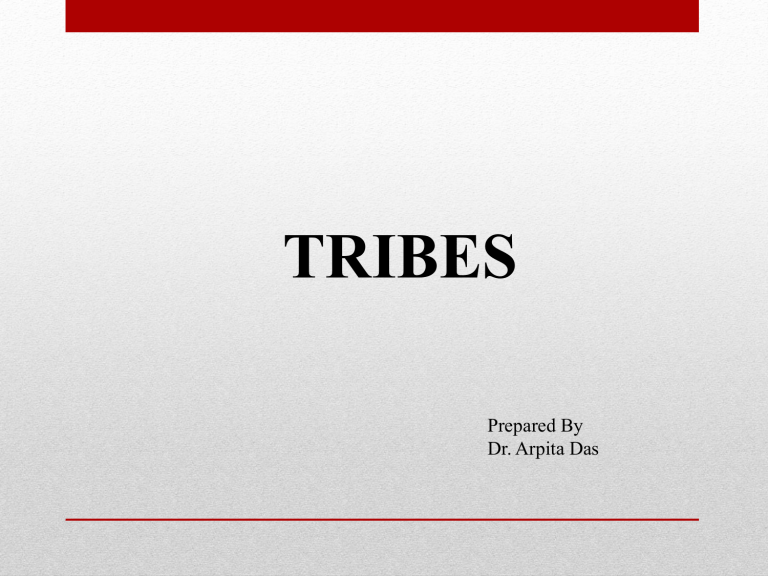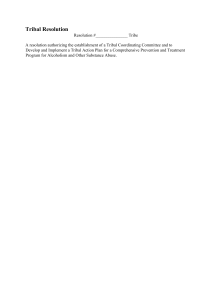
TRIBES Prepared By Dr. Arpita Das Identity According to the Oxford Dictionary of English, the word “identity” originated in the late sixteenth century from the Latin word “idem” which means “same.” The term states the “fact of being who or what a person or thing is,” and it also stands for “a close similarity or affinity” Identity is a collective aspect of a set of characteristics that define a person or a thing. It is a term which is both inclusive and exclusive because on the basis of ones identity one can get included or excluded in a group. No one can have a singular identity because one gains various identities on the basis of ones nationality, gender, region, ethnicity, language, caste, class, etc. One can be identified on the basis of his political, social, economic and ideological beliefs, too. A person can have multiple identities depending on his association or affiliation with various groups. Identity of Tribe First, geographical territory: this refers to the territorial and physical aspect of the tribal identity, which in common parlance is known in the slogan of Jal-JungleZamin (water-forest-land) symbiosis. Second, social organization: the tribal social organization in general is characterized by egalitarianism. In the villages tribals are still governed by the sahiyaro and madait concept. Third, economic organization: there is a tremendous collectively in the economic organisation of the tribals which is not found in other communities. Rather than having individualistic approach in their economic enterprises, tribals have a sense of social responsibility and co-operation. Their orientation is towards mutual sharing rather than hoarding. Fourth, political structure: Tribals have their own system of governance, which is characterised by self-rule and decentralisation of power. In this type of governance decision is taken by consensus and not by election or majority-minority votes. Fifth ,linguistic identity: language is one of the main identity markers. It clearly distinguishes one from the other because language is not just a means of communication but an important aspect of culture and identity. Sixth, constitutional recognition: the constitutional recognition for the tribals as ‘Scheduled tribes’ under Article 342 of the Constitution, has a special significance. WHO ARE THE TRIBALS ? The term ‘Tribe’ in Anthropology as defined by Wikipedia as a notional form of human social organization based on a set of smaller groups, having temporary or permanent political integration, and is defined by traditions of common descent, language, culture, and ideology. In different countries they are know by different names. In India the tribals are known as the Adivasis. The term Adivasi literally means ‘original inhabitants’. It is an umbrella term for a 5 heterogeneous set of ethnic and tribal groups believed to be the aboriginal inhabitants of India, although terms such as atavika (a Sanskrit word for forest dwellers), vanvasi or girijan (hill people) are also used for the tribes of India. Definition of Tribals The ILO convention 107 describes the tribals as those people “who are at a less advanced stage of development than those reached by the other sections of national community and whose status is regulated wholly or partially by their own customs and traditions” According to Imperial Gazetter of India , ‘a tribe is a collection of families bearing a common name , speaking a common dialect, occupying or professing to occupy a common territory and is not usually endogamous though originally it might have been so. Characteristics of Tribe 1. Common Territory: A tribe is a territorial community. It means the tribe has a definite territory in which its members reside. For example, the Naga, Rengama Naga, Sema Naga and other tribals reside in Nagaland, Garos Khasi, live in Assam and Meghalaya; Bhils in Madhya Pradesh; Thodas in Nilgri Hills of Tamil Nadu, and so on. 2. Collection of Families: The tribals constitute a collection of families. These collections may have various sizes. These families which normally have blood relationships among themselves could be matriarchal or patriarchal in nature. 3. Common Name: Every tribe has its own name. Each tribe is known to others by its distinctive name. Example of some Indian Tribes: Garo, Khasi, Naga, Munda, Santal. 4. Common Language: The members of a tribe speak a particular language. Different tribes speak different languages. These languages are not only different from the language of the civilised people, but they themselves differ from one another. Common language contributes much to the development of community feeling. 5. Common Ancestor: The tribals claim that they have a common ancestor. A major cause of the sense of communal unity in the tribe is “the tie of blood relationships” between its members arising out of common ancestry. 6. Common Religion: Religion plays an important role in the tribal organisation. The members of a tribe usually worship a common ancestor. Also, nature worship is common among them. In addition to the ancestral worship and nature worship. 7. Common Culture: Common culture of a tribe springs out from the sense of unity, common language, common religion, common political organisation. Common culture produces a life of homogeneity among the tribals. 7. Distinct Political Organization: Every tribe has its own distinct political organisation which looks after the interests of tribal people. The whole political authority lies in the hands of a tribal chief. In some tribes, tribal committees exist to help the tribal chief in discharging his functions in the interests of the tribe. 8. Sense of Unity: Unless and until, a group living in a particular area and using that area as a common residence, does not possess the sense of unity, it cannot be called a tribe. Sense of unity is an invariable necessity for a true tribal life. The very existence of a tribe depends upon the tribal’s sense of unity during the times of peace and war. 9. Prevalence of Dormitories: Tribal community has a peculiar feature which is evident in the form of common sleeping chambers or dormitories. Young boys and girls spend much of their time in the night in their dormitories and often they are vested with the responsibility of giving protection to the community people. 10.Simplicity and Self-sufficiency: A tribal society is not complex but simple in character. Hunting, fishing, collection of roots, fruits ,nuts, honey and forest products are their main means of subsistence. They are simple, honest ,frugal and some of them are very hospitable also. THANK YOU
